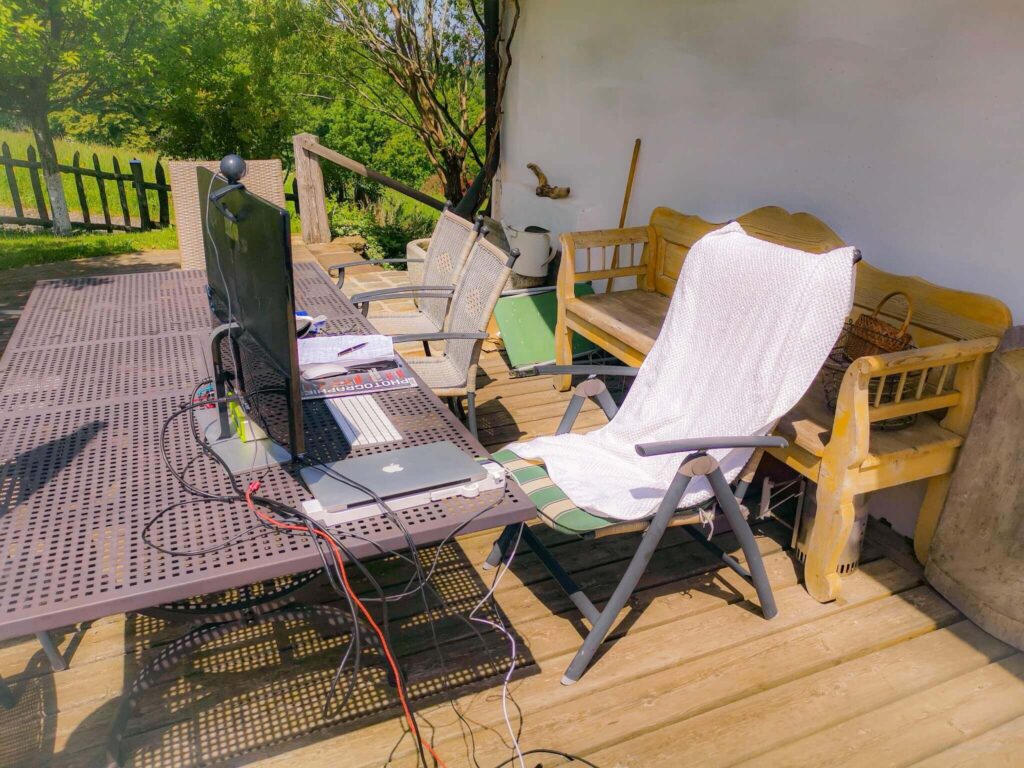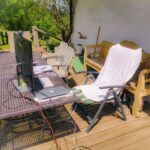Business2travel founder Fabian Hilpert has been a digital nomad for more than ten years. He has traveled to and worked from over 70 different countries. In addition to his work as an entrepreneur, Fabian conducts courses and training for various educational institutes while being on the move. In an interview, he talks about working in mountain huts and beach bungalows, which faux pas should be avoided and what else you should pay attention to in order to offer worldwide high-quality training courses on the Internet.
Why the combination of work and travel?
Wouldn’t it be easier to have a permanent office at home and then go on vacation abroad?
Of course, work still remains work, no matter where you are, but the time in between I just live a lot more intensely when I’m outside of my comfort zone. In the last ten years I’ve learned an incredible amount about other countries and their cultures and learned foreign languages. Every day can be completely new and unique. Of course, that is also exhausting. The amount of impressions can also be a bit overwhelming and sure, things go wrong that go wrong when you work in a hut in the jungle or on an alpine pasture instead of in the usual office environment.
Back then it was really difficult to even find a laptop that was suitable remote working.
There are a few things that you simply cannot avoid entirely. A lot has changed in the last few years which makes it a whole lot easier to live as a digital nomad. When I started traveling the world ten years ago, there were just a few like-minded people in my home country Austria. Back then it was really difficult to even find a laptop that was suitable for remote working. Today it’s a whole new game and with a few structures, that can be integrated in an ever-changing life and a few fundamental things to look out for, there is no big difference for me today from where I am teaching my online courses.

What are things that you should be aware of?
One of the biggest beginner mistakes is probably to rely completely on the internet in the accommodation or on the mobile network. It’s not that dramatic if you write articles and you don’t have any deadlines oder appointments to attend to. You can simply just change your location if needed. But if you are teaching online training sessions and 30 participants rely on you to be present as a trainer, unreliable internet connection can’t be a thing. It’s not a solution to run around Khaosan Road in Bangkok with your laptop in hand to find a good connection. That is not something you wish to do, I promise.

How can situations like this be avoided?
Nowadays I just run a free speed test the day before, for example via Ookla or WieistmeineIP.de. In order to be safe, the bit rate permanently has to be at least 10Mbit/s (upload and download). In addition I always have two different SIM cards from different providers in my luggage. One can be plugged into a smartphone in order to create a mobile hotspot for the laptop. The second is best placed in a mobile router or tablet, or it can be integrated into the smartphone as an eSim card. In Europe in particular, it is advisable to use a SIM card from your home country, as there are no roaming charges within the EU. Also you can book another service from the respective country. Even those who book a good hotel or AirBnB with WiFi or rent a co-working space for training are always well advised to have at least one additional SIM card for emergencies. Of course, there are also services such as Google Fi and others which can be used in these situation.
What are security measures you’re taking?
The power supply is just as important as a stable internet connection.
I always start my courses with fully charged batteries and have all chargers either plugged in or at least in reach. A classic mishap is a dying smartphone battery because the hotspot needs more energy than expected. This suddenly interrupts the Zoom conference. Valuable time is wasted by the time the cell phone is recharged and turned on again. Laptop batteries are also used more when a video chat is running with a lot of participants. Anyone who uses Bluetooth headphones, which I personally prefer, probably also knows the problem that the batteries are usually exhausted after two hours of continuous use. You can either recharge it during the break using the Fast Charge function, or you have a set of cable headphones or an extra pair of fully charged Bluetooth headphones to change to.

By the way, my professional tip for a very comfortable training atmosphere is a second monitor. Especially in training courses with digital topics, just like mine, it makes sense to be able to split the screen. Like that you can show the participants something directly on the network or on the computer and at the same time keep an eye on the group on your second screen. For digital nomads who like to travel light I recommend an IPad or, if available, the television in the hotel. With an IPad make sure that the batteries are full before starting a course.
When it comes to technology, we’re on the safe side now.
What other faux pas are there and how can you avoid them?
It is very unfortunate when the cell phone rings in the middle of a training and your mom wants to chat about the weather. That always applies, of course, also at home. Therefore: Always switch your mobile phone to flight mode during a meeting. Anyone who uses their phone as an internet source should at least put it on mute. Even more unpleasant than private calls are personal files, pictures and websites that suddenly open when you split the screen for everyone present. To avoid this you should create an additional user account for work on your laptop. Only files and folders that are relevant for the training should go on this professional account. Because even if work and everyday life often mix for digital nomads you should at least try to separate the two as best as you can.
What else can digital trainers do to present a professional image even in Bali or Jamaica?
Regardless of whether I do my training in a hotel room, in a beach bungalow or in a co-working space: I always prepare my surroundings in a way that nobody can tell the difference between a normal office environment. This means that there should be no clutter, dirty dishes, dirty laundry or a stack of pizza boxes in the video call. When in doubt, it is better to choose one of the common virtual, neutral backgrounds that Zoom and other video conferencing providers offer.

A highly illuminated face also paints a very unprofessional picture of your and your business. In addition, regardless of whether the sun is shining through the window or a lamp on the ceiling is shining in the background: Backlighting means that the head and face always appear dark in front of the screen, which makes it difficult for the participants to correctly recognize facial expressions. In the digital world, non-verbal communication is already more difficult, so if necessary I adjust the furniture in the room so that my face is properly and professionally illuminated.
How do you dress for online training?
Can you wear shorts in front of your computer when it’s boiling outside?
Even if the lower half of the body isn’t showing in the video: I still always put on a decent pair of pants. If, for whatever reason, I suddenly have to get up and forget about the swim trunks or joggers that I put on doesn’t leave a particularly good impression. Hawaii shirts and all sorts of vacation-wear are also a NO-GO for me in many training sessions. You look immediately more professional in an ironed shirt. And I do this not only for aesthetically reasons, this also has a psychological effect: those who dress professionally also feel more professional and convey content better. That’s why I only wear things that I would wear for a local training session in the seminar room.
Do you always put your cards on the table?
You can hide your Hawaiian shirt in your suitcase, but what about your tanned skin or other indications that you have been abroad for a long time?
I always tell my participants where I am right now. Working from abroad goes very well with what I am teaching because I want to teach others how to work from abroad and travel. But this can differ for everyone. There is no one size fits all solution. For example, if you hold a training session in front of frustrated office workers in the middle of winter, you have to be aware that it might not come across well and generate resentment and envy if you talk about your morning walk on the beach while all your participants have to make it through the city traffic in the pouring rain to get to work. Good to know: As soon as your participant know you work from abroad they forgive small mistakes like unstable connection way less.
Do you always plan your trips well in advance or do you book accommodation spontaneously?
The good thing about online training is that appointments are usually set weeks in advance. I already include this in my travel planning and I decide beforehand whether I should book a hotel, an AirBnB or an entire conference room for myself. When it comes to an intense day of courses it makes sense for me to invest money.
When it comes to an intense day of courses it makes sense to invest money.
If you are just at the beginning of your digital nomadic career and do not have a large budget for hotel stays, you should plan in advance exactly where you will be at the time of an upcoming training course. In many places there are co-working spaces where you can rent a desk for one or more days at a very reasonable price. You can still spend the night in shared rooms in the hostel or in a simply furnished beach bungalow. However, you should look at the workplace beforehand and make sure that you are sitting in a separate area for training and not in an open-plan office right next to the coffee machine, where other nomads meet for small talk every other minute.
How do you feel about working in cafés?
After all, the “digital nomad” with a laptop in a café is the epitome of the location-independent self-employee.
A quiet café – not a lively beach bar – should only be selected as a training location in an absolute emergency due to the lack of other alternatives. The following also applies here: stop by beforehand, check the power situation and WiFi and clarify with the staff whether it is okay if you block a table for several hours and only order something during the breaks.

There are also digital nomads who travel in their own campervan. Online training is also possible from there. The advantage: You work in a familiar environment, your own mobile home. Many “Vanlifers” have equipped their vehicles in such a way that they are powered by solar power and thus charge their devices. However, you are dependent on the weather and the hours of sunshine. It is safer to use the power supply on a campsite. The same rules apply to mobile Internet: It is essential to test WiFi on the campsite or mobile network in advance and, if in doubt, book a few nights in an accommodation.
What kind of people are suitable for life and location-independent work as an online trainer?
Of course you should like to travel and all the daily changes that come with this life. But in general I can only recommend anyone who is already teaching digital online training from home to try it out from abroad. You don’t have to quit your apartment or sublet it for months and go on an adventure for an indefinite period of time. Why not just go to southern Europe for three weeks with a laptop in your luggage and do just one or two training sessions from there to test the whole thing for the first time within a limited time frame. If you look out for the basics, you definitely have more to gain than to lose.






